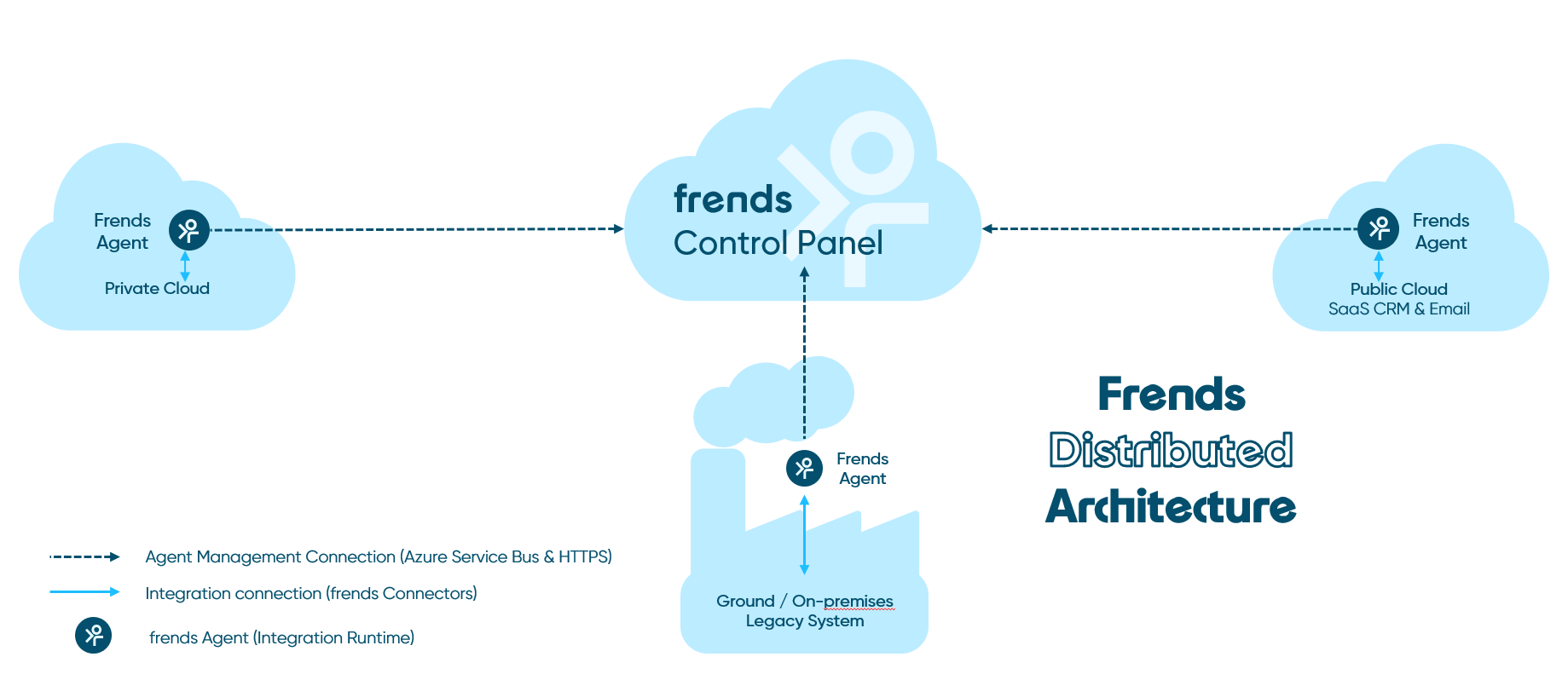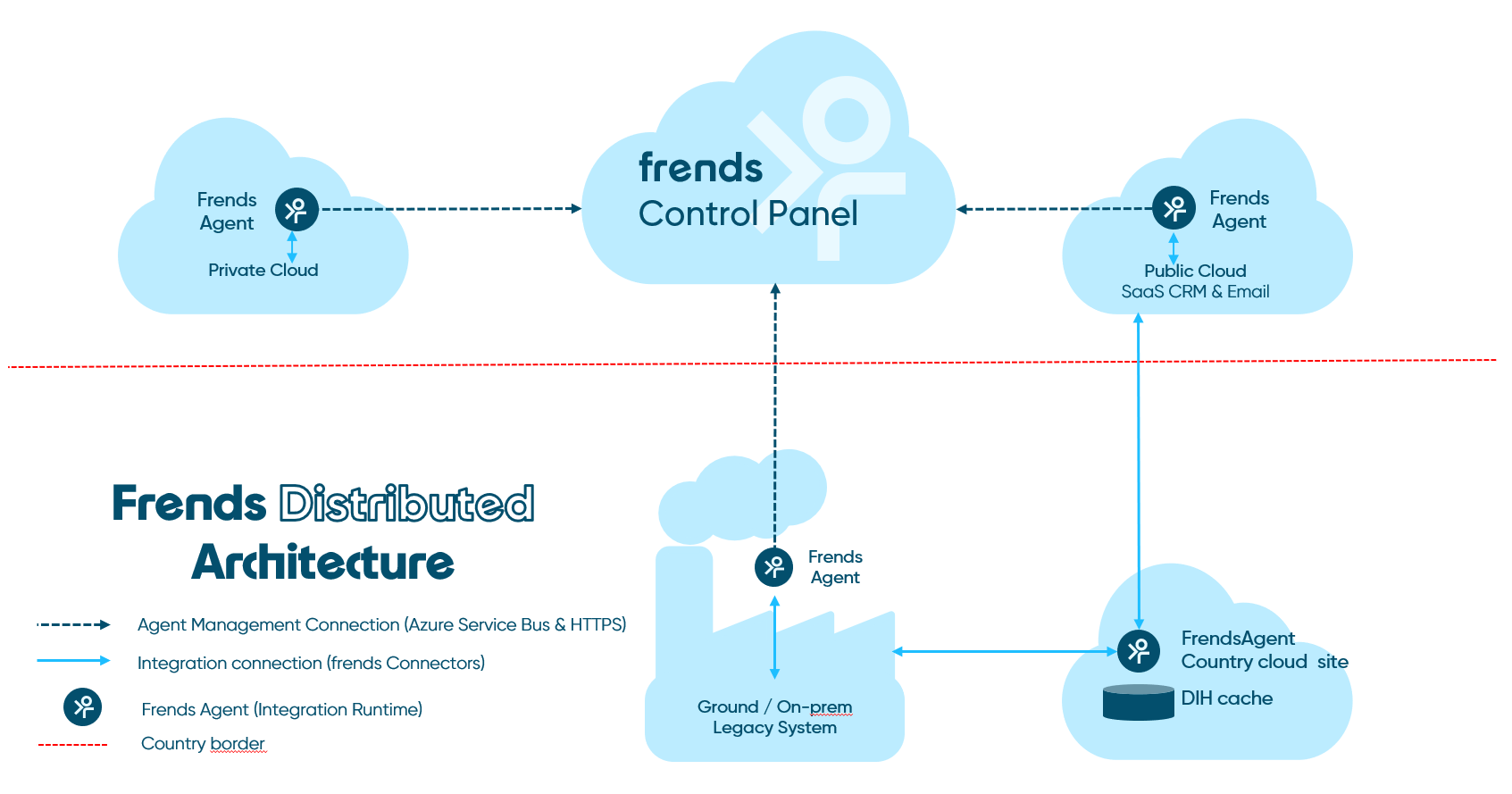Learn how Frends iPaaS simplifies multicloud strategies, ensuring seamless integration, data control, and resilience across multiple cloud environments.
Multicloud is a hot topic in the digitalisation strategy. What is multicloud, and what are the benefits and hindrances of multicloud? This article describes what they are, what are their pros and cons and how a modern integration platform helps you with multicloud.
What are the modern cloud approaches?
When the big public cloud players, such as AWS, Azure and others, started to be the de-facto infrastructure providers for SaaS, the need for the system to co-operate from cloud to "ground" arose. By the word "ground", I mean the data service centre or private cloud provider that already existed. At that point, many integration platforms-as-a-service went hybrid, which meant that they operated on both sides: public cloud and ground at the same time. Hybridness is often achieved via distributed execution architecture, where the development and monitoring are done via centralized UI, and the execution is separated in an individually deployable "engine". Execution Engines can then be deployed in the cloud or ground. Hybrid cloud solution combines data centre or private cloud and public cloud.

This picture illustrates how a hybrid iPaaS - in my case Frends - can be deployed.
Edge computing is a public cloud solution where the computational power is brought close to the place where it is needed. It solved first, for example, the capacity issues of video streaming. Some public cloud vendors offer localized or country-specific services, like file storages.
Multicloud is an approach where two or more public cloud vendors are used together as an infrastructure, SaaS or PaaS.
But why would you use several public cloud vendors when you can get better prices when concentrating on one vendor and avoid outbound communication cost?
Why Multicloud?
-
Harness the individual strengths of each cloud provider. The offering of cloud services in major platforms vary a lot - if you want to follow the best-of-breed strategy in your development and software, you'll have to go for multi-cloud. For example, one cloud provider can offer you local edge services, which help you keep up with the regulations like GDPR or other governmental rules like "data must not leave the border of our country".
-
Avoid a cloud vendor lock-in. If you use a single cloud provider as your chosen development platform, you'll end up with incredible vendor lock-in unless you enforce your developers to create applications that work on multiple platforms.
-
Increased security and resiliency. If you overlap, e.g. specific infrastructure and backups (files and services) in two public clouds, you are better prepared for the unthinkable. Sometimes - luckily not often - there are big cloud vendor wide outages.
Read more: Five reasons to choose a multicloud strategy
Challenges of Multicloud
Of course, everything has a price tag.
-
Complexity increases. This is quite obvious as there are just more moving parts. Sometimes this leads to a situation that you cannot follow where your data is - and that is a security issue.
-
Higher costs as you may not get the best volume offers. Or there might be "cloud boundary costs" for data traffic that don't occur within cloud provider but do between separate cloud platforms and on-prem.
-
Messy architecture and no centralized control as the complexity grows. This occurs mainly if no multi-cloud strategy and plan exist.
-
Harder to automate processes and workflows as there is a boundary between process steps when they occur in different cloud platforms. The problem does not apply in recording based RPA, but recordings are suitable only when no other means are available.
-
Integrating systems might be challenging. The need for live event-based information in, for example, modern ERPs and CRMs is growing. Without the right tools, this connectivity over the cloud boundary can be challenging.
Read more: Five multicloud strategy challenges that you might face
How an integration platform may help you with multicloud

-
Modern iPaaS allows click-and-play deployment in any cloud or on-prem. You decide whether your API is published in the on-prem ground, private cloud or public cloud API by API. Modern iPaaS can publish and deploy them even in both at the same time.
-
iPaaS in multi-cloud Allows a process orchestration to be executed anywhere. One step (in Frends, we call it Task) can be performed on-prem and another in the cloud even if they are part of the same orchestration.
-
A single visual view of a process that may be distributed in several clouds and on-prem reduces the complexity and audit trail of a process or an API in a multi-cloud environment.
-
You can harness the individual strengths of each cloud as a part of the API and process. For example, AWS Rekognition is an excellent cost-efficient choice for an image to text converter.
-
Follow the edge computing idea and keep your data close where it is processed and needed. The use of an iPaaS allows you to build, for example, Digital Integration Hub, where individual data storages are close to the point of use.
-
Ensure where your data is by deploying your integrations and data storages on the country-specific cloud or private cloud. This is useful in GDPR issues or when it is regulated that data does not leave your country. This is a pretty popular use case in multi-cloud environments.
-
The most modern iPaas platforms, like Frends enterprise iPaaS, can run simultaneously in the cloud and on-prem in a manner that on-prem works when the cloud is down due to a global outage. This leads to the best up-time and availability for your APIs and process automation.
If you want to hear more on how Frends iPaaS can help you with your multicloud strategy, don't hesitate to contact us.
